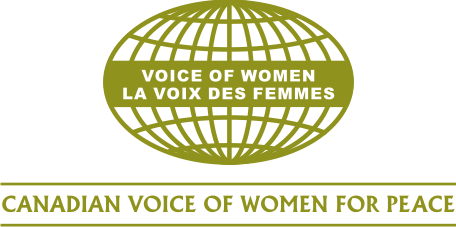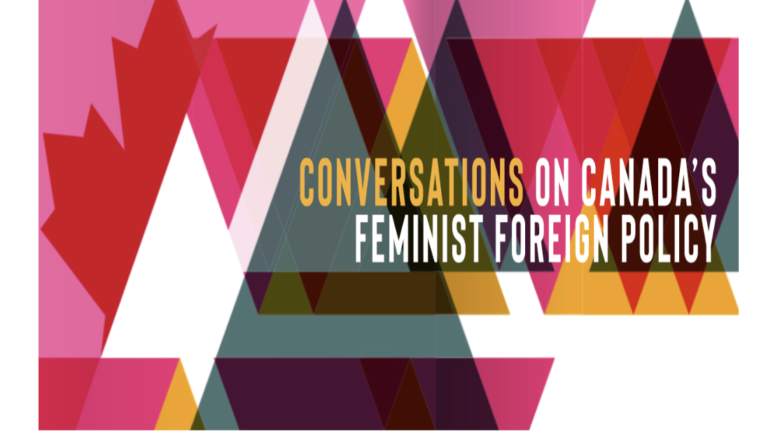The Canadian Voice of Women for Peace contributed to the developing White Paper on Feminist Foreign Policy which is set to be launched in 2021.
We, along with numerous other organizations who contributed, are committed to shaping foreign policy that is centred around human security and not militarized state security.
You can read our submission below
See our submission on the Amnesty International website
Or, you can also download the submission here
Canadian Voice of Women for Peace submission to the Global Affairs Canada Feminist Foreign Policy Review
The Canadian Voice of Women for Peace wishes to commend the Government of Canada for spearheading and launching the first-ever Feminist Foreign Policy in 2017. This is a proud achievement and policy commitment for our nation. That being said, there are a number of key gaps within the current policy which we wish to address and offer recommendations for Canada’s next Feminist Foreign Policy (FFP).
Firstly, conceptions of foreign policy and international power structures have traditionally been theorized through realism and liberalism lenses. Both such lenses place the figure of the state at the centre of security and power. The state then is the primary actor in responding to possible conflicts. Fundamentally, tying together state, security and conflict places stereotypically masculine gender identities on this realm of international relations, and, as such, greatly limits the transformative power and peace building of critical feminist perspectives.
Realism argues that states are the main players that compete for dominance in an anarchic system, with the main goal of advancing their power and security. Liberalism places the state as the main actor manufacturing security through governance and institutions. A feminist approach defines security through the individual and personal experience, henceforth, shifting the priority from state security to human security.
A truly feminist foreign policy should work to deconstruct the gender hierarchy found in international relations, looking to transform conceptions of power that are reliant on gendered binaries (for example: private (feminine)/public (masculine), dominant (masculine)/subordinate (feminine)). While gender and power relationships differ depending on cultures and countries, what seems left out of conceptions of power that inform foreign policy, is the idea that personal power relationships operate beyond contained sovereign states.
We emphasize the need for a feminist foreign policy that works at a transformative level, recognizing structural and personal violence that bleeds into the bigger question of security. Feminist foreign policy cannot exist in a country where women and girls fear for their security based on gender constructs. True security and peacebuilding rely on eliminating gender dynamics of domination and subordination found within personal, local, and international systems.
This is important in critically analyzing Canada’s ‘Feminist Foreign Policy’, often focused on greater engagement of women in militarized action. For example, the Elsie Initiative’s mission to “increase meaningful participation of uniformed women in UN peacekeeping operations” at the pace it is changing now it would take “decades for military and police women’s participation in peacekeeping” to reach a number reflective of Canada’s diverse population. Canada provided an initial $15 million toward this fund that provides resources for countries “that contribute troops and police, and for UN organizations to support the deployment of trained and qualified uniformed women to UN peace operations”.
Feminist foreign policy cannot be truly realized by simply adding more women into existing security structures that are associated with militarized defense. The mere addition of women to existing security structures replicates and reproduces the patriarchal dynamics of violence and conflict at play in dominant security discourse. In other words, the addition of more women into power structures and policies, that are inherently harmful to women and girls, does not make them feminist nor transformative. Rather, a feminist foreign policies would analyze the existing power structures – a state-centric approach to militarized security and defense policy – and would seek to systemically transform them into human-centred approaches to peace and security.
The current FFP lacks clarity on differentiating a transformative feminist approach aimed at root causes for inequality and conflict, and one that focuses on the inclusion and empowerment of women and girls. Without structural change, increased women’s representation is not enough; it treats the symptom as opposed to the illness. It is the structures reliant on patriarchy and discrimination that must be transformed, not the number of women holding positions within them. Following the indicators (see Appendix) set out in a Feminist Foreign Policy: A fine line between “adding women” and pursuing a feminist agenda, we recommend that Canada fully align itself with this type of feminist foreign policy approach. This would go beyond simply adding women into existing spaces, and to re-evaluating the systems of oppression present in society today.
In terms of political dialogue, we recommend that Canada’s FFP shift to include a women-centered approach to conflict resolution and peacebuilding. We see a direct commitment to improving women’s roles in political dialogue in Germany’s approach, where political dialogue is outlined as one of the three main prongs. In terms of safety and well-being, we recommend that, rather than following the concept of adding women to systems such as the military, women should be included in spaces designed for peacebuilding, as they are often the ones most affected by violent conflict and can contribute solutions that support their community by uplifting peace and security. In terms of creating an empathetic community, we recommend that the federal government follows an approach to keep all decisions consistent with their Feminist Foreign Policy. Regarding an inclusive and intersectional approach, we recommend that the federal government work to further include the advice of women-led, intersectional civil society organizations. Finally, regarding a gendered analysis, a new Feminist Foreign Policy focus on re-evaluating and challenging existing systems of oppression, and applying a gendered analysis to all decisions.
For VOW, a transformative approach for a new FFP includes taking substantive steps toward disarmament in accordance with the 2018 UN Agenda on Disarmament. The total elimination of nuclear weapons and other weapons of mass destruction should be at the forefront of any feminist foreign policy strategy. There is a clear relationship between gender and nuclear weapons. The testing and use of nuclear weapons have disproportionate impacts on women and girls. Women remain underrepresented in nuclear weapons negotiation spaces, and the overall gendered discourse surrounding nuclear capacities reflects realist gender binaries of masculinity, femininity, dominance, and sub-ordinance. Even a limited deployment of these weapons would result in catastrophic humanitarian consequences. The Treaty on the Prohibition of Nuclear Weapons (TPNW) is the first international nuclear weapons treaty that addresses gender dynamics, both in its content and the processes by which it was negotiated. Ratifying the TPNW signals a clear support for feminist approaches to security and foreign policy and would markedly accelerate Canada’s implementation of the Women, Peace and Security agenda.
Appendix:
| Indicator | Feminist Foreign Policy |
| Political Dialogue | A prevalence of political dialogue in conflict resolution, diplomacy and trade |
| Safety and Well-being | A security concept with the focus on individual well-being |
| Empathetic community | Communities of states based on empathy, trust, transparency, respect, global justice, beyond the border, and shared responsibility |
| Inclusion and intersectional approach | Intersectional approach based on expertise and experience of civil society and local communities |
| Gender analysis | Deconstructing power relations on the basis of intersectionality |

